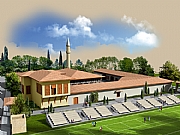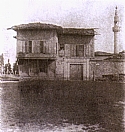Projects & Buildings

| Architect | Dr. M. Sinan Genim/Belma Barış Kurtel |
| Assistants | Özgen Esen / Ayfer Atılgan |
| Employer | A Proposal to the Municipality of İstanbul |
| Static | Attila Çaydamlı |
| Mechanic | Selim Evyapan |
| Electiricity | Korkut Daşdemir |
| Purpose | Archery Museum / Arrow Shooting Range |
| Project Year | 2006 |
| Land Area | 15.185 m² |
| Construction Area | 12.468 m² |

Arrow and archery are activities which many nations have considered rather important as a sport of battle besides hunting. Our nation gave weight to archery. They made the military practises some kind of competition both in times of war and peace. Considering the role that the archers played in the victory of Manzikert, beginning from the times that the Ottomans began to expand, archery was seriously taken into consideration. A practise range was established in Bursa during the reign of Sultan Orhan. Later Yıldırım Beyazıd built a similar practise range in Gelibolu.
In the past, tekkes were not just meeting places of the religious orders but also places where military sports took place. There are two qualified tekke structures in İstanbul. One of them is Okmeydanı Kemankeşler [Shooters / Archers] Tekke, the other is Unkapanı Pehlivanlar Tekke, of which nothing remains. Every year Tekke of Okmeydanı used to open at Hıdırellez in 6th of May, and for six months archery practises were made every Monday and Thursday. Beside the archery practise, games such as jumping a ditch with a pole, sword competitions, javelin throwing, wooden ball and truncheon were played. The Tekke of Okmeydanı was in fact a sport club that continued the Ahi tradition. To take an archer to Okmeydanı [Archery Square], to allow him to shoot an arrow and to expel him were only possible with the permission of the Sheikh of the tekke.
Although there is information that Fatih Sultan Mehmed established a military camp during the siege preparations of Istanbul and that the ships sailed to Golden Horn were built here, the name Okmeydanı is not mentioned in the reign of Fatih. The witnesses such as Tursun Bey, Barbaro, Ducas, Francis and Kritovoulos do not give any information about this subject. Much later, in the history of Münemcimbaşı, it is written that the ships that sailed to the Golden Horn by Fatih were built in Okmeydanı. However, many scholars disagree. Nevertheless, it is agreed that an important military camp was established at or near Okmeydanı during the siege and rear guards were stationed here.
After the conquest of Istanbul, the celebration of the victory was made at Okmeydanı under the leadership of Akşemseddin. According to some sources though, the booty was shared at a military camp positioned here after the conquest. For these reasons, it is said that Fatih built a mescid in this area, however, no remains of such a building were found here. A building can be observed at the plan of Istanbul of Matrakçı Nasuh dating to 1537. But it resembles a civil structure rather than a mescid. In the endowment of Fatih, there is no statement such as Okmeydanı / Meydân-ı Tîr or Dergâh-ı Tîrendâzân. It is known that Okmeydanı was registered in the trust of the father of Beyazıd II.
After the reign of Fatih, Turkish features became dominant especially during the reign of Beyazıd II. Many members of Islamic orders were brought to the city. For this reason, Beyazıd II. is also cited as Beyazıd the Sofu in some sources. Parallel to these activities, the Tekke of Okmeydanı was most probably built at the end of 15th century or at the beginning of the 16th century. Some sources mention a closed building in the name of Sorkun [Sivrikoz] Çardak at this square at the beginning of the reign of Beyazıd II and it was demolished by Vezir İskender Paşa, the Governor of Bosnia. Same sources claim that feeling sorry for what he did, later on, he built a mescid and a tekke at the same place. This building consisting of a Kasr-ı Hümâyun or the chamber of the Sheikh, mescid, kitchen, and storehouse is the same building that we see in the miniature of Matrakçı Nasuh. The well curb that survived to the present demonstrates how Matrakçı Nasuh was realistic in showing his observations. It is said that there is a minaret of the mescid built in 1518. But we do not see this detail in the work of Matrakçı Nasuh. Although some sources claim that these structures were built by Mimar Sinan, there is no mention of these in the records of Sinan.
Gürcü Mehmed Paşa [Georgian] repaired the buildings in 1034 [1624-1625] and changed the area into winter quarters by adding a mimbar to the mescid. The buildings were renewed in the reign of Ahmet III. A minaret was added by Ebubekir Ağa in 1184 [1770-1771]. It is clear that the Mescid of Okçular Tekke did not have a minaret until the third quarter of the 18th century, similar to the rest of the district mescids. Okçular Tekke was once again repaired by Mahmut II in 1234 [1818-1819]. A drawing of this period is available at the album of 1820 of Carl Gustaf Löwenheim. Surrounded by a high wall, the building with two stories and two sections in front of the rectangular wide courtyard is probably the tekke and the chamber of the sheikh. At the back is a long and thin minaret with a single balcony and a lead crown on the top. To the north, at the back of the wall of the courtyard is a building with a single storey. The courtyard has three entrances, one of them is under the chamber of the sheikh, the others are to the right. The vicinity of the building is completely empty. Some grave stones are observed under the high cypress. They are thought to be belonging to Kukacı Dede and important archers. The drawing gives an idea about the character of the buildings and the original lead crown of the minaret. Because the three photographs taken at a later date show the minaret in ampiric style and with a stone crown. Changing of the crowns of the minarets in Istanbul in 1890’s occured at the Mescid of Okçular Tekke.
The only photograph belongs to Architect Hikmet [Koyunoğlu] where the chamber of the sheikh and other structures can be partially seen. There are striking similarities between this photograph and the drawing of Löwenheim. However, the opening above the entrance door is an arch of two colored stone blocks, whereas the photograph demonstrates a sizeable door frame and a flat lintel. Another stone building is observed at the southeastern corner of the courtyard at a photograph dating to 1930. The chamber of the sheikh and its additions most probably had burnt down before this picture was taken, because the concrete water reservoir [vault] is visible under the chamber of the sheikh. The ampiric stone crown made in place of the thin, delicate lead crown is also visible at this frame.
A three dimensional restitution of Okçular Tekke made by Keramet and Metin Nigar is also available. However, regarding the chamber of the sheikh, there are important differences between the restitution and the photograph of Architect Hikmet. For this reason, I think it will be useful to prepare a new trial based on the mentioned evidence.
Beginning from the 1950’s shanty settlement invaded Okmeydanı and its immediate vicinity. It is very well known that the concrete sections of the tekke were taken and used as building material during this process. In 2005, the tekke and its surroundings were rescued from the shanties and the area was taken into protection. Excavations that will be made under the light of written sources will be able to reveal the remains of the building and thus will be used in the reconstruction of the tekke of Okmeydanı. Immediate action must be made so that Istanbul will gain its profound sport area once again. During these works, the Namazgah of Okmeydanı near the tekke must be brought to life. Part of its anteroom is covered with debris, while the balustrade and the inscription at the entrance are lost.
As clearly seen, Okmeydanı is a profound sport area. An important function must be given to this region regarding the arrangement of the vicinity, besides the tekke. Making research to provide a sport area that existed more than 500 years, to build a modern shooting range in the immediate vicinity and to arrange the tekke as an archery museum is a serious subject that needs to be handled.





